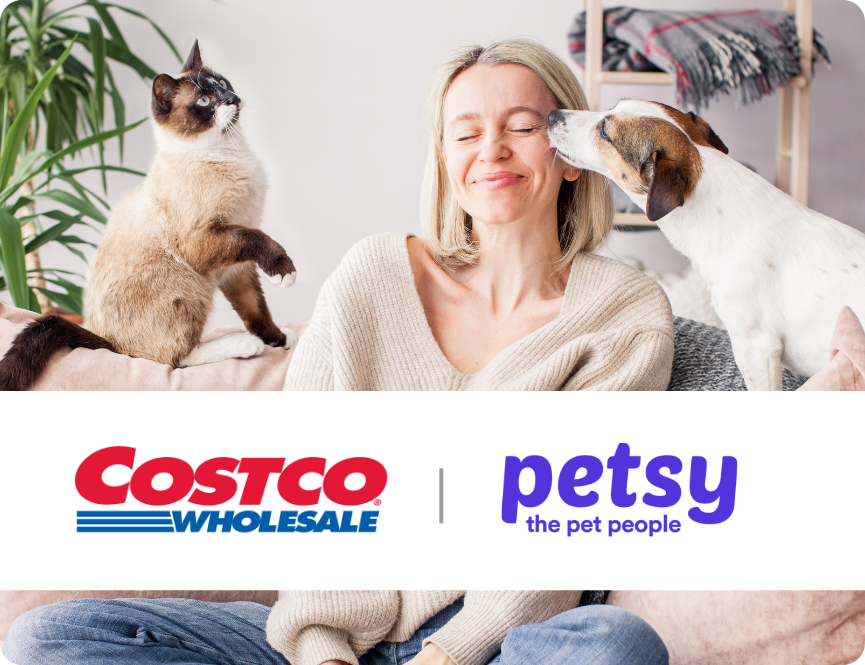What is the Best Pet Insurance?
So, what’s the best pet insurance? Well, we can’t exactly tell you that—it’s not something we can legally advise on, and “the best” will be different for every pet family. But as Pet People, we can help you figure out what’s most important when you’re looking for coverage. For us, the best pet insurance is the one that meets your coverage needs, within your financial means and is there to support you when you need it most. So for us, getting the most value for what you pay for pet insurance is what’s important to us. Especially because pet insurance isn’t cheap. Let’s walk you through a few things to look for when you’re shopping around for pet insurance.
Meeting Your Coverage Needs
To find the right coverage for you and your pet, it helps to understand the types of pet insurance available and what each one covers. When you understand what each type includes, and how coverage levels differ, it’s easier to compare policies and see what fits your pet’s needs best. We walk you through how to compare pet insurance policies apples for apples in more detail in this article.
Types of available pet insurance
In Australia, pet insurance generally comes in a few different types of coverage, that can vary by provider:
Accident-Only Cover: This covers costs related to injuries from accidents, such as broken bones or wounds. It doesn’t cover illness-related expenses.
Accident and Illness Cover: A more comprehensive option that covers both accidental injuries and illnesses. It can include coverage for a wide range of conditions, from minor issues, like infections and allergies, to more serious diseases like cancer.
Accident and Illness Cover with add-ons: Some plans also cover routine care treatments like vaccinations, desexing, and flea and tick treatments, alongside coverage for accidental injuries and illnesses.
Routine Care: Can be offered as an optional add-on, which helps to cover some costs for preventative care and wellness treatments, such as vaccinations, microchipping, and desexing. The coverage limits for these treatments are usually lower than for other claimable conditions.
At Petsy, we offer accident and illness cover with add-ons only. We believe that in an emergency, you shouldn’t have to worry about whether you chose the right level of coverage when you bought your policy. Our goal is to provide peace of mind.
When comparing pet insurance, policies typically have similar key components: an annual limit, benefit percentage, excess, and optional extra benefits. Your premium is based on the levels of coverage of these components. So when comparing pet insurance, the key is to understand how each component works differently across providers. This helps you identify the best policy that meets your needs and offers the most value.
Let’s break down these components so you can see where policies are similar and, more importantly, where they differ.
Coverage and inclusions
Most providers offer tiered policies, such as small, medium, or large, or bronze, silver, or gold and will try to bucket you into one of these categories. Generally, the lower-tiered policies offer less coverage and are more affordable, while the higher-tiered options provide broader coverage with fewer restrictions.
At Petsy, we understand that even two pet owners in the same suburb with the same breed may have different financial needs. That’s why we do things differently here and offer one policy that is fully customisable to suit your coverage and financial requirements.
Annual benefit limit
The annual benefit limit is the maximum amount your pet insurance will pay for all claims in one year. Once you reach this limit, you’ll need to cover any additional costs until the next policy year.
At Petsy, regardless of the annual limit you choose, the list of covered accidental injuries, illnesses, and conditions remains the same. Often with other policies, if you pick a larger benefit limit, the list of your inclusions will also increase or decrease accordingly. At Petsy, no matter which annual limit you choose, the list of covered injuries, illnesses, and conditions remains consistent. Whether you opt for a $5,000 or $25,000 limit, your coverage remains the same. Plus, unlike many other providers, we don’t impose sub-limits, so there are no restrictions on how much you can claim for specific conditions or claims.
Benefit percentage
The benefit percentage is the portion of each eligible vet bill that your insurance covers. For example, if your benefit percentage is 80%, the insurance will cover 80% of the eligible bill, and you’ll be responsible for the remaining 20% (after any excess is applied). This is typically pretty similar across the industry. Benefit percentage ranges from 70% to 100%.
Excess
The excess is the amount you need to pay out of pocket before your insurance starts covering costs. Across the market, excesses can vary. It can be applied per claim, per condition, or per policy year.
At Petsy, our excess works a bit differently. Instead of applying an excess per condition or claim, we use a once-off annual excess. For instance, if your annual excess is $300 and your first vet bill is $200, the remaining $100 can be applied to your next approved claim. You only need to meet this excess once per year.
Optional extra benefits
Optional extra benefits are additional coverage options that can be added to the standard coverage. When doing your research you will find that there will be a lot of dissimilarity in the market for optional extra benefits. A lot of providers don’t even offer optional extra benefits. You will find that some providers offer routine care as ‘add-ons’ and if they do, sometimes only offered as part of plans with the highest level of coverage.
At Petsy, we offer extras cover for dental illness, behavioural conditions, and specialised therapies. Plus, we don’t have sub-limits on these. However, it’s important to note that routine care, like regular teeth cleaning, isn’t covered. Claims need to be related to a dental disease like gingivitis, periodontal disease, or tumours.
We offer optional extras only for pets under the age of three. Why only under three? By the age of three, most pets may develop dental diseases, and adding extras later would mean these conditions are considered pre-existing. We want to ensure you’re not paying for coverage that can’t be used.
Vet consultations
The option to include or exclude coverage for vet consultation feed is unique to Petsy.
- When you receive a vet bill, one of the line items will typically be for the vet consultation. We’re one of the few providers (or the only that we know about) that allows you to exclude vet consultations from your coverage. We do this for a few reasons:
Many of our customers are vets, vet nurses, or clinical staff who receive significant discounts or don’t pay for consultations at all - Some customers are already on wellness plans, so we don’t want them doubling up
- Pensioners often get discounts with their vets
It’s worth noting that the cost of vet consultations can increase significantly during emergency hours. If you don’t fall into one of these categories, it might be worth considering including vet consultations in your coverage.
Customer service and how a provider makes things easier for you
Choosing pet insurance isn’t just about the coverage—it’s also about how well the provider supports you when you need it most. Here are some things to think about:
- Is it easy to file a claim?
- How do they handle pre-existing conditions?
- Can they bill your vet directly?
- How easy is it to reach their support team?
- What’s their cancellation policy?
- Can you add extras later?
An easy way to check out a provider’s service is by looking at reviews on sites like ProductReview.com.au and Google Reviews. These platforms offer real feedback from customers, giving you a sense of how well the provider handles claims and customer support. We walk you through what to look for in pet insurance reviews in this article here.
At Petsy, we’re proud of our top ratings on ProductReview.com.au, TrustPilot, and Google, which reflect our commitment to looking after you and your pets. We’ve also been recognised with Canstar’s Outstanding Value Pet Insurance Award for two consecutive years in 2023 and 2024.
We’re the Pet People, and we understand pets because we’re pet parents too. When you call us, you’ll speak to someone right here in Australia who gets how things work with vets in this country.
Matching Coverage to Your Financial Needs
When comparing pet insurance, a common mistake is to focus on price alone. Choosing the lowest premium without comparing the actual coverage could mean paying for gaps in protection.
To offer more budget-friendly options, some providers might limit coverage through stricter exclusions or sub-limits, which can limit how much you can claim. These details may not be obvious when obtaining a quote. You may also be met with a hefty price increase when it comes to renewal time.
At Petsy, our focus is on providing high-quality coverage and service that offer long-term value. Our Australian-based team ensures you always speak with a local pet lover. Through our experience, we understand that more extensive coverage tends to align with our customers’ expectations. That’s why we focus on high-quality insurance with no sub-limits. Our customisable policy allows for coverage levels to be adjusted. For instance, increasing the annual excess can help lower your premiums. Plus, our Australian-based team understands local vets and is here to help you find coverage that makes sense for you.
Reviews
Customer reviews from review platforms like ProductReview.com.au and TrustPilot can offer insight into how providers handle claims and customer service. When reading reviews, pay attention to details like:
- Was it easy to submit a claim?
- How long did it take to process?
- Were explanations provided if a claim was denied?
These details are crucial because it will likely reflect the experience you will have with the insurance provider.
Similarly, customer service is another critical area to consider. Reviews can tell you how responsive and helpful the support team can be. Do they address concerns and questions promptly? Are they knowledgeable about the policy details and able to guide you through tricky situations? Good customer service can make a huge difference during stressful times.
We do want to add that to read reviews with a grain of salt, —sometimes, claims are denied for legitimate reasons, like pre-existing conditions, which can lead to unhappy customers. However, if you see the same issues popping up in multiple reviews, it might be a red flag.
Comparison Sites
Third-party sources like Forbes Advisor, Canstar, and Mozo offer expert reviews. They provide a third party review of the industry and provide a comparative view between many different providers and different offerings. They can be a guide to help you make sense of what offerings are out there.
Awards
Many of these comparison sites also give out awards for different categories like best value, best for multiple pets. These awards are awarded to winners based on a certain category and can help if you are looking for a specific like best for young pets. We’ve won Canstar’s Award for Outstanding Value two years in 2023 and 2024.




